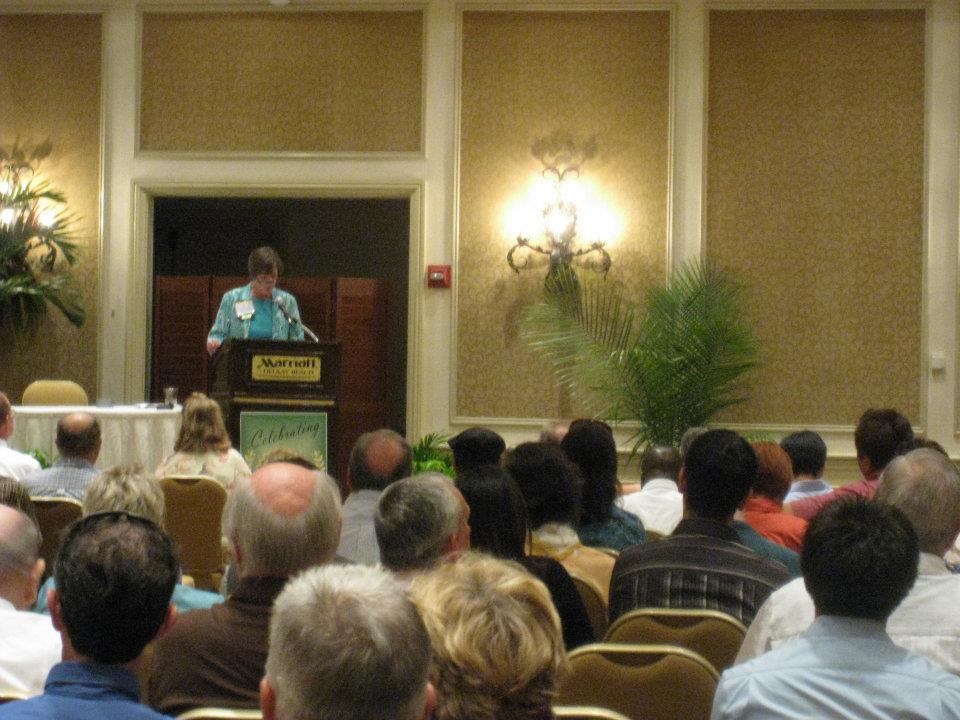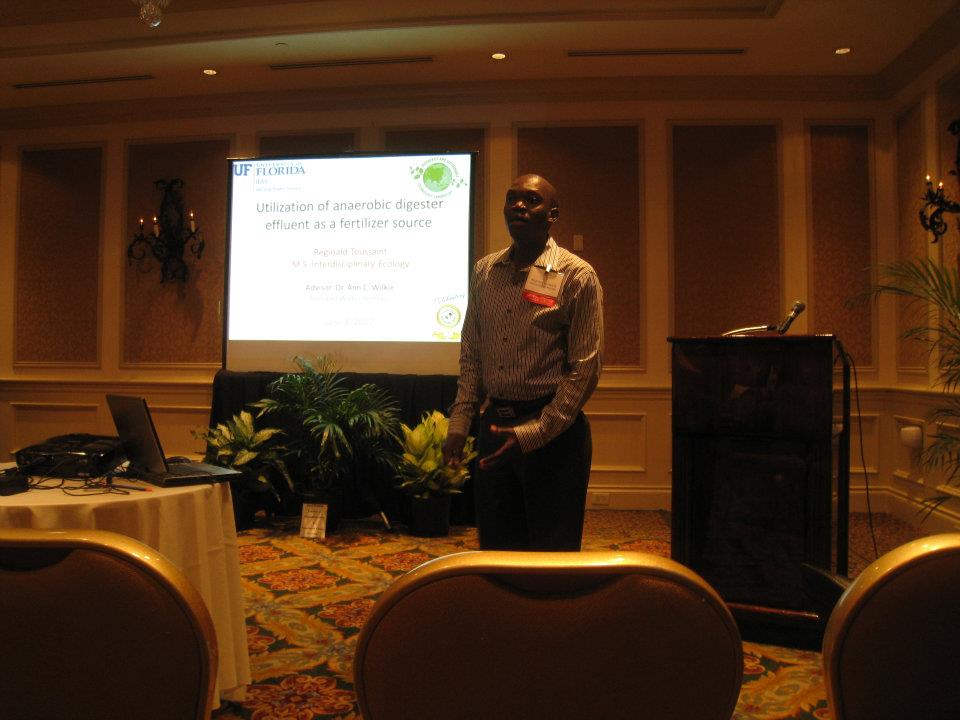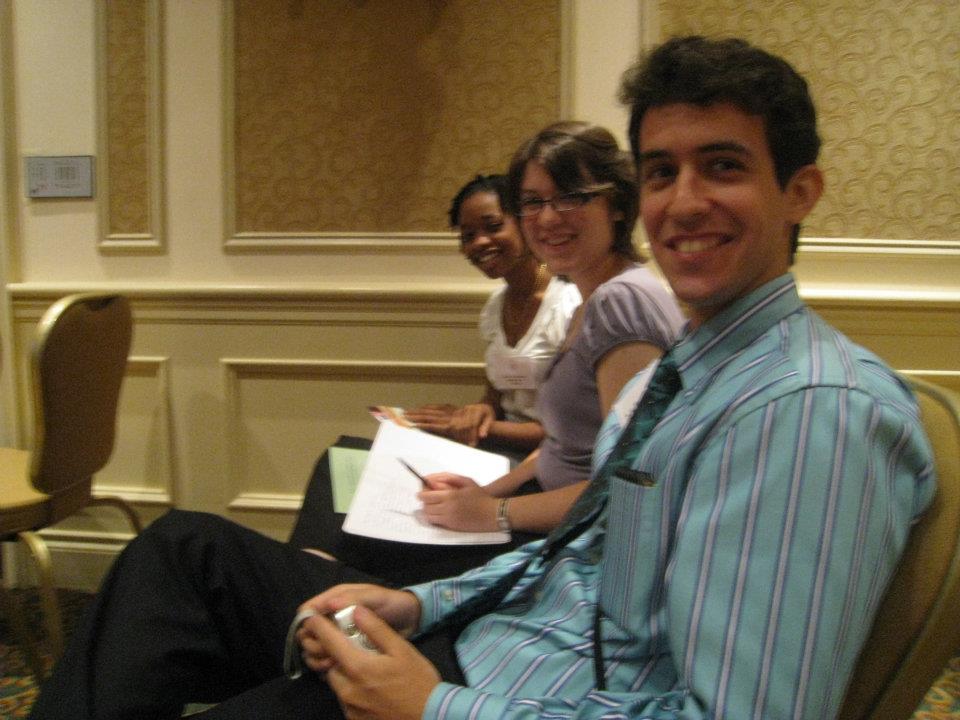Florida State Horticultural Society Conference
June 3-4, 2012
Delray Beach, FL
Author: Candice Prince
Website

From July 3rd-4th the UF BioEnergy and Sustainability School (BESS) interns attended the Florida State Horticultural Society’s conference in Delray Beach. This conference included oral and poster presentations on topics ranging from natural resource management to landscape horticulture. The BESS students were able to experience a scientific conference, learn how professional scientific presentations are delivered, and attend the presentation by the BioEnergy Lab’s graduate student Reginald Toussaint.
The keynote speaker of the conference was K.M. Warner, the President Emerita of the American Horticultural Society in Florida and a former employee with Disney. Her presentation was on plant blindness, a cultural affliction where people are unable to notice plants in their environment or recognize their importance. Causes of the problem are that humans tend to look within 0-15 degrees of their line of sight while plants are mostly outside of that range; and adults view the outdoors as unsafe for children and discourage them from playing outside. At the Walt Disney World Resort, strides are being made in fixing plant blindness by placing dramatic flower beds and hanging baskets at eye level, as well as having attractions such as the Land Pavilion and the International Flower and Garden Festival at Epcot. Research can also help show the importance of plants, with current papers stating that cities with improved landscapes have lower crime rates and that plants help hospital patients heal faster.
The majority of presentations we attended were in the Natural Resources section. The morning session focused on Soils, Crops, and Environmental Quality with the first presentation being the “Utilization of Anaerobic Digester Effluent as a Fertilizer Source” by R. Toussaint. He explained that as the global population rises, so must food production and therefore the need for crop fertilizers. The Haber–Bosch process of creating nitrogen fertilizer is complex and energy intensive, and phosphate rock is a non-renewable resource, making it prudent to find more sustainable sources of fertilizer to keep up with the growing demand. The effluent left behind by the process of anaerobic digestion is one such alternative. No significant difference in plant health was found between using the anaerobic digester effluent and using conventional fertilizer sources, showing that the effluent is viable and competitive as a fertilizer.

D. Campbell next presented “Determining the Agronomic and Physiological Characteristics of the Castor Plant (Ricinus communis L.): Developing a Sustainable Cropping System for Florida.” The seeds of castor are 37-60% oil by weight, and the plants themselves possess ricin and allergenic components. The research factors were plant cultivar (Brigham versus Hale) and the effects of a plant growth regulator (PGR) on castor (decreasing the plant size increases the amount of resources devoted to seed production). Both cultivars reached a root depth of 800 mm after 20 days, with a 20mm/day growth rate at 21 days. In addition, the PGR was shown to potentially have an effect on plant height.
S. Friedman presented “Biochar Applications in Agriculture for Resource Conservation”. Biochar is the highly porous, carbon-rich product of pyrolysis (carbon-rich biomass undergoing thermal decomposition). Its advantages are that it is renewable and reduces nitrous oxide and methane emissions from the soil. Disadvantages include unknown economic and environmental impacts. Friedman hypothesized that biochar will increase water retention, but observed that the fertilized half of samples within experimental trials had perished. Further testing will help prove the value of biochar in both agricultural and environmental applications.
W. Orozco spoke next, presenting “Can Lotus (Nelumbo spp.) be Used to Remove Heavy Metals from Contaminated Florida Soils?” Orozco presented data that suggested the use of the Asian Lotus as a heavy metal, P, N, and pesticide sink. He found that the lotus can contain very high levels of heavy metals while showing few visual signs of toxicity. Al, Fe, and Na were more highly concentrated in the rhizomes, while Mn was had a higher concentration in the leaves and Cu showed little difference.

The Natural Resources Section then turned towards presentations on wildlife, starting with a presentation on the use of barn owls to control rodents in the Everglades Agricultural Area (EAA) by R.N Raid. Rodents cause an average of $30 million/year in damages in the EAA, and chemical rodenticide is expensive and hazardous. Nest boxes were set up to attract barn owls, which are native to the area and prey on rodents. The program has been a success, with one of the highest densities of barn owls in the state and growers using less rodenticide. The remaining presentations were on water quantity and quality, starting with a project by F. Hazan where he used the Watershed Assessment Model (WAM) to evaluate two different plans for a residential development. To use WAM, you input parameters and get outputs for water quality. The model shows promise, demonstrating in this experiment that Plan B would result in a higher water quality than Plan A. R.V. Tyson gave a presentation on aquaponics. Potential problem areas with aquaponics include the lack of extension production guidelines and that fish seldom provide all of the necessary nutrients for the plants. Tests for E. coli in the wastewater have shown levels below the acceptable thresholds, suggesting that this is a safe system. There currently is a high cost and a risk to aquaponics, making fish prices high and necessitating a high-end marketing strategy. The final presentation was “Greenhouse Culture of Submersed Aquatic Vegetation ‘Sod’” and was given by L.A. Gettys. In this project, two different ecotypes (wide and narrow) of the aquatic plant Vallisneria americana were grown on two different matrix materials (burlap and coir) to determine if they could be successfully installed in natural areas as a sod. It was found that the narrow ecotype with the coir matrix was the most successful, and by using this method researchers were able to plant about 46 square feet of V. americana in just a few minutes.
Many of the above presentations relate to bioenergy and sustainability, and thus expanded our knowledge in these areas in addition to introducing us to a scientific conference and scientific presentations. For example, R. Toussaint’s project explains a way to use a byproduct of making biogas that is sustainable and has applications for helping third world countries where conventional fertilizer is too expensive for common use. Absorbing all of the information from the sustainability related projects helped spark ideas for our own projects in addition to supplementing what we’ve learned in our lectures. The take away message from this field trip is twofold; the first is the format followed by presenters on how scientific research should be presented at a formal conference, while the second is that there are many researchers focusing on bioenergy and sustainability and that there is still much to be learned.